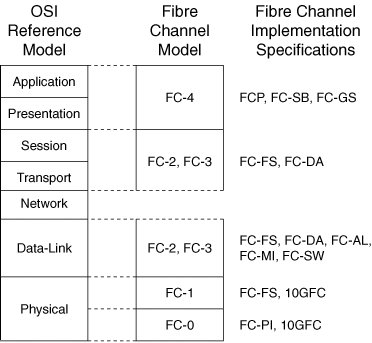Fibre Channel Architecture and ANSI T11 Model
| The ANSI T11 subcommittee loosely defined a five-layer network model in 1994 as the basis of the Fibre Channel architecture. The layers of the Fibre Channel model are referred to as levels in ANSI documentation, but they are called layers within this book. The five layers of the Fibre Channel model are FC-0, FC-1, FC-2, FC-3, and FC-4. Whereas the Fibre Channel model has not changed, the Fibre Channel architecture has undergone numerous changes. The Fibre Channel architecture is currently defined by a large series of specifications published primarily by the ANSI T11 subcommittee. Fibre Channel Model and the OSI Reference ModelThe Fibre Channel model does not map neatly to the OSI reference model. In fact, the Fibre Channel model itself is scantly defined. A quick glance at the Fibre Channel model indicates that the Fibre Channel architecture operates at the OSI physical, data-link, and application layers. However, to fully understand the Fibre Channel model, it is necessary to infer details from the Fibre Channel specifications. This approach is unorthodox, and it undermines the purpose of a network model. These points notwithstanding, we attempt herein to clearly define the Fibre Channel model so that readers can better understand how it relates to the OSI reference model. Similar to the OSI reference model, the Fibre Channel model layers build upon each other starting with FC-0 as the foundation. One notable exception is the FC-3 layer. The Hunt Group functionality defined within FC-3 builds upon the node-addressing functionality within FC-2. However, the Link Services defined within FC-3 are required for FC-2 operation. So, FC-3 logically resides above and below FC-2 in the OSI provider/subscriber paradigm. Despite this, ANSI documentation invariably depicts FC-3 above FC-2 in the vertical stack representing the five layers of the Fibre Channel model. This book depicts FC-3 and FC-2 as peers whenever the Fibre Channel model is diagramed. Fibre Channel SpecificationsANSI T11 publishes two types of FC specifications: protocol standards and technical reports. Each protocol standard describes a subset of the overall FC functionality. For example, the FC-SW-4 specification describes interswitch behavior. The latest version of each protocol standard is recommended for new product implementations; however, the latest version of a protocol standard does not render obsolete previous versions of the same standard or related standards. This precludes immediate technical obsolescence of products that are based on previous versions of the standard. Unfortunately, this gives rise to interoperability issues. In addition, the protocol standards provide many options to accommodate a wide variety of deployment scenarios. This flexibility also can cause interoperability issues. So, technical reports are published to promote interoperability by restricting the options that might be used in a given environment. For example, the FC-DA specification provides a set of behavioral restrictions for end nodes in arbitrated loop environments and a separate set of behavioral restrictions for end nodes in switched fabric environments. The latest draft version of each in-progress FC specification is available on the ANSI T11 website while the work is in progress. When a specification is completed, the draft versions are archived, and the final version must be purchased for a nominal fee. The Fibre Channel specifications do not map neatly to the Fibre Channel model. The details of how to implement the functionality defined within each layer of the Fibre Channel model are spread across multiple specification documents. That said, a close look at the Fibre Channel specifications reveals that considerable end-to-end functionality is supported. So, an accurate description is that the Fibre Channel architecture operates at the OSI physical, data-link, transport, session, presentation, and application layers. Extrapolating this information to better understand the Fibre Channel model indicates the following:
Originally, the FC-PH series of documents specified much of Fibre Channel's functionality and spanned multiple OSI layers. Later specifications separated portions of the OSI physical layer functionality into a separate series of documents. The OSI physical layer functionality of Fibre Channel is now principally specified in the FC-PI and 10GFC series. The OSI data-link layer functionality is now principally specified in the FC-FS, FC-DA, FC-SW, FC-AL, and FC-MI series. There is no OSI network layer functionality inherent to Fibre Channel, but the FC-BB series provides various methods to leverage external networking technologies, some of which operate at the OSI network layer. From the Fibre Channel perspective, external networks used to interconnect disparate Fibre Channel storage area networks (FC-SAN) are transparent extensions of the OSI data-link layer service. A subset of the OSI transport layer functionality is provided via the N_port login (PLOGI) and N_port logout (LOGO) mechanisms as specified in the FC-FS, FC-DA, and FC-LS series. A subset of the OSI session layer functionality is provided via the process login (PRLI) and process logout (PRLO) mechanisms as specified in the FC-FS, FC-DA, and FC-LS series. Protocol mappings enable Fibre Channel to transport many types of traffic, including OSI network layer protocols (for example, IP), application level protocols (for example, SCSI-3), and data associated with application-level services (for example, Fibre Channel Name Service). These mappings provide a subset of the OSI presentation layer and application layer functionality. Most of the mappings are defined by the ANSI T11 subcommittee, but some are defined by other organizations. For example, the Single-Byte Command Code Set (SBCCS) mappings are defined in the ANSI T11 subcommittee's FC-SB series, but the SCSI-3 mappings are defined in the ANSI T10 subcommittee's FCP series. Figure 2-6 compares the Fibre Channel model to the OSI reference model and lists the Fibre Channel specifications most relevant to storage networking. Figure 2-6. Fibre Channel Relative to OSI |
EAN: 2147483647
Pages: 196
